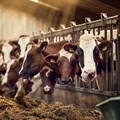
Subscribe & Follow
#AfricaMonth
In the news
Innovating in agriculture is central to addressing food security and achieving affordable nutrition
The climate crisis compounds this reality, with many communities in East and Southern Africa experiencing extreme weather patterns such as severe drought and flooding. It follows, that with this context, food security remains a dire concern, further compromising easy access to affordable nutrition for all.

Since before the Covid-19 pandemic, the planet had already been dealing with interesting population dynamics. In the global north, an ageing population was and still is impacting many economies’ abilities to efficiently produce food. The implication on a significant reduction in the working-age population, along with shifting immigration policies has left the food industry compromised.
Curbing food insecurity
In the global south, a rising population means increased demand for food, and consequently, increased use of arable land and water. It follows that a paradigm shift is necessary to curb food insecurity and efficiently address the United Nations’ second sustainable development goal (SDG) to end hunger, achieve food security and improved nutrition and promote sustainable agriculture
The answer to this global quandary does not have a known reasonable panacea. However, there is a central convergence point we can focus on to deliver significant change, and it is proving effective in many pilots. That is, in the area of agriculture, employing fundamental shifts to farming practises that can match growing demand, while protecting and perhaps even restoring the environment.
Sustainable farming practices
Regenerative agriculture, as it has come to be known, is a collective of sustainable farming practices that, by design, work in harmony with nature, while maximising output in both quantity and quality of food. The approach borrows from indigenous practices that have been used by ancient communities for centuries, and over the years, has evolved to include cutting-edge technology to finesse efficacy. The result, better quality raw materials for food manufacturing, while significantly reducing the release of harmful greenhouse gases to the atmosphere.
A pilot project that has applied these practices is Skimmelkrans Boerdery in South Africa’s Western Cape province. The farm, which is poised to be South Africa, and possibly Africa’s first net zero dairy farm by 2023, has co-opted regenerative agriculture practices in its day-to-day activities.
For instance, the farm uses intercropping in pastures, mixing different types of grass such as ryegrass and clover, accompanied by zero tillage, fertilised with cattle manure, and irrigated using recycled water. The impact is seismic. By repurposing manure as a natural fertiliser, the farm reduces the amount of carbon released by commercial fertilizer use. 1.36kg is the average mass of carbon released into the atmosphere for every 1kg of chemical fertiliser produced.
The estimated mass of carbon captured in the ground in each hectare through the process of crop photosynthesis and sequestration is 10 metric tons. Skimmelkrans is 600 hectares in size and therefore prevents 600 such masses of carbon from entering the atmosphere each year.
Through all of this, the milk production output from the farm has increased by 11%, and this milk goes into manufacturing products such as Nestlé Nespray, Nestlé Milo, Nestlé Culinary Milks and Nestlé Everyday. That this is local sourcing further extends the positive impact of this approach, contributing to local economies through agripreneurship and job creation.
Improving farmer livelihoods
A shift to regenerative agriculture is proving effective in the efforts to reverse climate change, while delivering increased yields and improved farmer livelihoods. At scale, this paradigm shift in food and farming systems is critical in directly addressing food insecurity security, especially in global south economies where increasing demand for affordable nutritious food correlates with increased land use.
Addressing SDG 2 requires collective action that centres communities that are vulnerable to the double threat of climate change and food security. For food manufacturers, collaborating with producers such as the farming community is one way to truly unlock the power of food to enhance the quality of life for everyone on this planet. Only then, can we effectively curb food insecurity while protecting our planet.
About Takudzwa Mupfurutsa
Takudzwa Mupfurutsa, Business Executive Officer, Dairy at Nestlé East and Southern Africa Region (ESAR).Related
Rooibos farmers unite agriculture, conservation for biodiversity 18 Feb 2025 Pick n Pay's fight against hunger in South Africa 15 Oct 2024 Waterberg Boerdery and Yellow Door Energy inaugurate solar and battery energy storage system 14 Oct 2024 Mandela Rhodes Foundation 2024 Äänit Prize winners announced 18 Sep 2024 Mogale Maleka: Leading the way in water-efficient farming as a GoGettaz finalist 8 Aug 2024 2024 GoGettaz Agripreneur finalists announced 5 Aug 2024











